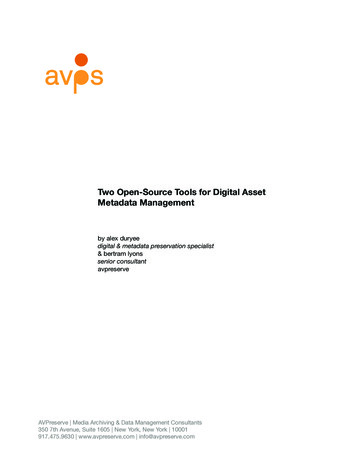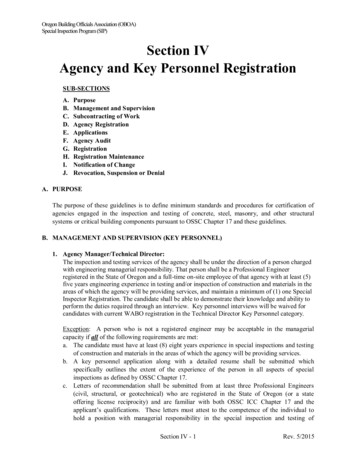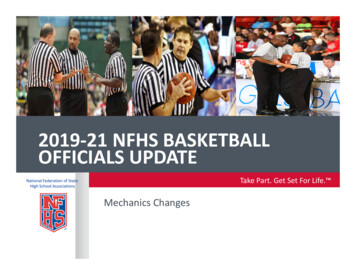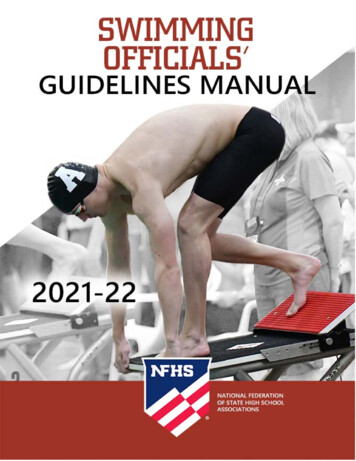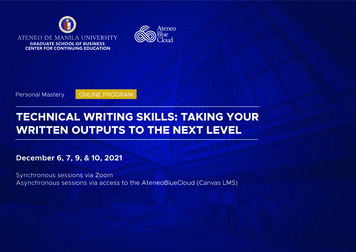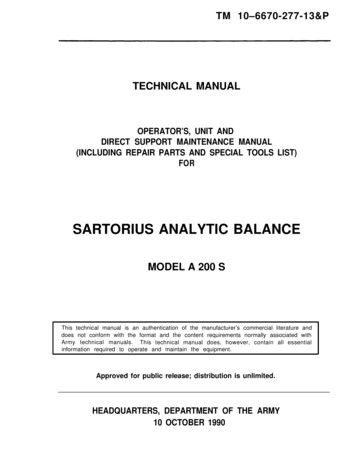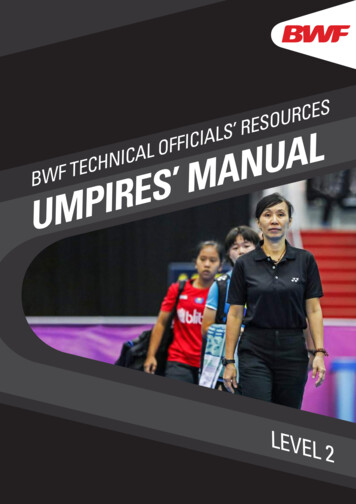
Transcription
EVEL2
BWF TECHNICAL OFFICIALS’ RESOURCESUMPIRES’ MANUALLEVEL 2Published by:BADMINTON WORLD FEDERATIONUnit 1, Level 29Naza Tower, Platinum Park10 Persiaran KLCC50088 Kuala LumpurTel 603 2381 9188Fax 603 2303 9688Email: bwf@bwfbadminton.orgWebsite: bwfcorporate.com Badminton World FederationFirst published May 2020ISBN National Centre – National Library of MalaysiaISBN 978-967-18034-1-7All rights reserved.No part of this publication may be reproduced, distributed,or transmitted without the prior written permission of the BWF.Printed by Fussian Advertising & Printing Sdn. Bhd.Kuala Lumpur
ACKNOWLEDGEMENTSThe BWF would like to acknowledge and thank the following individuals and organisations who havemade a significant contribution to the development of this manual and the other components of theresources.MATERIALS WRITER Christopher LawrenceEDITOR Sharon SpringerUMPIRE EXPERT PANEL Gilles Cavert Torsten Berg Diraj Gooneadry Zheng Sanliang (Sandie) Peter Cocker Carol Ui Fhearghail Christopher TrenholmeCONTINENTAL CONFEDERATIONS Badminton Africawww.badmintonafrica.com Badminton Asiawww.badmintonasia.org Badminton Europewww.badmintoneurope.com Badminton Pan Amwww.badmintonpanam.org Badminton Oceaniawww.badmintonoceania.orgALL PHOTO CREDITS: BWF/BADMINTONPHOTOMORE INFORMATIONThe resources for Technical Officials are available in different languages. The material can bedownloaded from the BWF Education website: development.bwfbadminton.comBADMINTON WORLD FEDERATIONUnit 1, Level 29Naza Tower, Platinum Park10 Persiaran KLCC50088 Kuala LumpurTel 603 2381 9188Fax 603 2303 9688bwf@bwfbadminton.orgWebsite: bwfcorporate.com
CONTENTSSECTION 1. INTRODUCTION 1.1 BWF Technical Officials’ Resources 1.2 Manual Overview 1.3 Umpiring Resources SECTION 2. ELITE-LEVEL UMPIRE QUALITIES 2.1 General 2.2 Expected Behaviours 2.3 Summary SECTION 3. PRESENTATION 11124449103.1 General 3.2 Personal Appearance 3.3 Umpire Uniforms 1010103.43.53.63.73.83.9111112131516Demeanour Posture Voice Announcements Decision Making Summary SECTION 4. STANDARDISATION ASPECTS 174.1 Introduction 4.2 March-On 4.3 The Toss 4.4 Warm-Up and Ready to Play 4.5 March-Off 4.6 Vocabulary 4.7 Continuous Play 4.8 Changing Shuttles 4.9 Calling of “Fault” 4.10 Obstruction 4.11 Correcting Line Calls 4.12 Summary 171719212123232627282930SECTION 5. COURT AWARENESS 315.15.25.35.45.5Introduction The Court Equipment Coaches Summary 3131323335
SECTION 6. MISCONDUCT 6.16.26.36.46.56.6Introduction Types of Misconduct Stepwise Approach for Continuous-Play Issues General Considerations for Issuing Warnings and Faults for Misconduct Misconduct During Intervals Summary SECTION 7. SERVICE JUDGING 7.17.27.37.47.57.67.7Introduction Philosophy of Approach Best Practices and Standardisation in Service Judging Undue Delay During Service Fixed-Height Service Device Other Service Judge Responsibilities Summary SECTION 8. MISCELLANEOUS TOPICS 8.18.28.38.48.5Introduction Player Clothing Instant Review System Electronic Scoring Use of Social Media SECTION 9. CONTINUOUS IMPROVEMENT 9.19.29.39.49.5Introduction Self-Reflection Feedback Making and Implementing a Development Plan Summary SECTION 10. SELF-ASSESSMENT QUESTIONS 636566
Welcome to the BWF Level 2 Umpires’ Manual, which forms part of the BWF Technical Officials’Resources. The BWF is committed to providing quality resources to assist in the training of technicalofficials from grassroots to international level. This resource is free for anyone to use in improving theirumpiring skills.The BWF Technical Officials’ Resources are outlined in Table 1.1.RESOURCESEQUENCETARGET LEVELLINE JUDGES’ MANUALSINGLE LEVELFrom grassroots through highest world levels.LEVEL 1Up to and including national level.LEVEL 2Up to and including continental level.LEVEL 1Up to and including national level.LEVEL 2Up to and including continental level.UMPIRES’ MANUALREFEREES’ MANUALTable 1.1. Overview of BWF Technical ResourcesThese resources are available to all Member Associations to use in training their technical officials. Eachcountry will have their own structure for training, evaluation and certification of technical officials. Forthose who are interested in forming part of the technical officials team, the first step is to contact yournational federation to inquire about opportunities and procedures.1.2 MANUAL OVERVIEWThis Level 2 Umpires’ Manual forms part of the BWF Technical Officials’ Resources outlined in theprevious section. It is aimed at: experienced national-level umpires who are looking to start umpiring internationally; continental-level umpires who are looking to polish their skills (including those who have aninterest in progressing to BWF accreditation).As such, the basic umpiring knowledge and procedures covered in the Level 1 Manual will not beaddressed in detail here. For a refresher on the following fundamentals of umpiring, readers should referto the sections of the Level 1 Umpires’ Manual noted below in Table 1.2.TOPICLEVEL 1 UMPIRES’ MANUAL PAGESBadminton basics6-9Umpiring overview13 - 15Umpire scoresheet35 - 43Basic umpiring match procedures for umpires17 - 27Types of service fault and basic service judging31 - 34Table 1.2. Level 1 Umpires’ Manual References for Basic Umpiring TopicsUMPIRES’ MANUAL LEVEL 21.1 BWF TECHNICAL OFFICIALS’ RESOURCESBWF TECHNICAL OFFICIALS’ RESOURCESSECTION 1. INTRODUCTIONSECTION 1. INTRODUCTION1
BWF TECHNICAL OFFICIALS’ RESOURCESUMPIRES’ MANUAL LEVEL 2SECTION 1. INTRODUCTION2This Level 2 Manual builds on the technical content addressed in Level 1, which has hopefullybecome second nature to the umpire through extensive practice at local-, regional-, and national-leveltournaments. The subject areas covered in this Level 2 manual can be broadly categorised as follows: Topics covered in the Level 1 Manual, but re-examined from a more advanced perspective.The emphasis changes in many cases from simply considering “what an umpire shoulddo” to discussing “how an umpire should do it”. Special focus is given to presentation andcommunication. Standardisation of all aspects of umpiring. The higher the level of tournament officiated the moreimportant this aspect of umpiring becomes when applied to areas as varied as continuous play,misconduct, and service judging. Standardisation also applies to presentational procedures such asmarch-on and march-off. Discussion of interpretation of specific laws and recommendations. Certain points that sometimescause confusion among umpires at all levels, which often leads to inconsistent application, arepresented at appropriate places in this manual. For example, topics like obstruction (Law 13.4.4)and a player delaying in returning to court after an interval (Law 16.2) are covered in detail. Introduction to specific topics relevant only for umpiring at elite-level tournaments.Table 1.3 shows the general outline of this manual.SECTIONBRIEF DESCRIPTION1Introduction and overview of manual contents2Required qualities for elite-level umpiring – presentation, control, knowledge, teamwork,leadership3Presentation – physical appearance, demeanour, posture, voice, decision making, communication4Standardisation aspects – march-on and march-off, toss and warm-up, continuous play, shuttlechanges, obstruction, correcting line judges5Court awareness – players, coaches, court, equipment6Misconduct – stepwise approach, feel for the game, being proactive, general guidelines forhandling incidents on court7Service Judging – philosophy of approach, consistency of calls, service measuring devices8Special topics – clothing regulations, electronic scoring, Instant Review System, use of socialmedia9Continuous improvement – how and why umpires should continue to improve their skills duringtheir careersTable 1.3. Outline of Content of Level 2 Umpires’ ManualIn order to provide concrete examples, video links have been added throughout the manual. These linkscan be accessed on the Video Clips page of the Technical Officials section at the BWF Developmentwebsite. The clips show real-life moments during badminton matches where technical officials facedsome of the situations described in the manual.1.3 UMPIRING RESOURCESThe higher the level of tournament, the greater the demands and the higher the pressure on umpires.At the international level, players will be relying on the umpire’s sound decision making and judgement.
Laws of Badminton Instructions to Technical Officials (ITTO):An invaluable document for understanding how to apply and interpret the Laws, as well as offeringgeneral umpiring advice. Vocabulary:All experienced international umpires are expected to use the approved English vocabulary nomatter where in the world they may be umpiring. Players, Coaches and Educators, and Technical Officials Codes of Conduct:An important duty of the umpire is to manage the behavior of the players and coaches participatingin a match. The Codes of Conduct for these persons describe what is acceptable and what isn’tand can form the basis of decisions an umpire makes around issues concerning misconduct.Of course, umpires themselves are held to high standards of conduct while at a tournament,as related to their high visibility and responsibility in carrying out their duties professionally. TheTechnical Officials Code of Conduct contains useful reminders as to the expected behavior.The following resources are also key for umpires’ ongoing development: BWF Umpire and Service Judge InstructionsThis PowerPoint deck of slides is updated periodically and emphasises presentationaspects that umpires and service judges are expected to adopt at the higher level ofthe game. It is a useful resource, as it offers concise yet comprehensive guidancearound standardisation of many different procedures to be implemented at continentaland BWF-level tournaments. These can be accessed using the “Download” arrow ficials/umpires/ Personal NetworkAll of the above sources of written material are undoubtedly useful. Equally valuable, though, canbe the discussion with peers, especially around issues and questions where an umpire is uncertainor is curious as to the best course of action regarding a specific circumstance in a match. Learningfrom the experience and insights of other umpires who may have faced these situations, or atleast thought about them, can add helpful context to the Laws and ITTO. All umpires who areserious about improving their skills and being as well-prepared as possible to face any situationthat might arise are encouraged to build and maintain a network of umpiring colleagues withwhom they can discuss and debate ideas as needed.During matches, umpires may need to make decisions that require them to recall and apply laws andrecommendations from various documents. For example, in dealing with an incident of misconduct,the umpire may need to recall, with just a few seconds of deliberation time, relevant content from theLaws, ITTO, and Players Code of Conduct. In deciding what to do, the umpire will also need to considerany specific instructions from the referees at the daily briefings, and then weigh all of this against theumpire’s feel for the game and the context of the situation.It is only natural for umpires to feel a bit stressed in such circumstances. However, they will becomemore comfortable by gaining as much officiating experience as possible, especially at more competitiveand high-profile tournaments. And of course, the more familiar umpires are with the materials citedabove, the more confident they will be in reaching a decision. As we will see in the next section,confidence is one of the key attributes that an umpire needs to be successful at higher-level national andinternational tournaments.UMPIRES’ MANUAL LEVEL 2To keep fresh and up to date, umpires who are committed to continuous improvement should regularlyconsult the following documents, which are updated periodically. The most recent versions are availableon the Statutes page of the BWF website:BWF TECHNICAL OFFICIALS’ RESOURCESAlso, umpires will be under the scrutiny of their peers, spectators and perhaps a TV audience as to howthey handle, for better or worse, the development of the match. Fortunately, there is no shortage ofresources available for umpires to consult in order to thoroughly prepare themselves for working at ahigh-level tournament.SECTION 1. INTRODUCTION3
BWF TECHNICAL OFFICIALS’ RESOURCESUMPIRES’ MANUAL LEVEL 2SECTION 2. ELITE-LEVEL UMPIRE QUALITIES4SECTION 2. ELITE-LEVEL UMPIRE QUALITIES2.1 GENERALThere has never been a better time to pursue a passion in badminton umpiring. The profile of the sportis growing internationally thanks to increased investment and sponsorship, more exposure on TV andthe Internet, and the charisma of the superstars of today’s modern game. At the highest levels of thesport, these changes have led to greater rewards for players, with the world circuit of tournamentstotaling millions of dollars in prize money. This is accompanied by an ever-increasing intensity in players’search for world ranking points to gain qualification to the Olympic Games, the ultimate prize for manytop badminton athletes.Technical officials have not beenexempt from these changes. Increasingrewards for players means that the needfor high-performing referees, umpiresand line judges has never been greater.Accordingly, in 2018 the first group ofsemi-professional referees started work– an elite group of referees assigned tomany of the biggest tournaments in theworld, with a mandate to raise standardsand drive consistency throughout thewider referee workforce. And in 2020,the first semi-professional umpireswill be seen on court driving a similarobjective.The possibility of someday being a partof the most prestigious tournaments inthe world is a motivation for many, butnot all, umpires when they first decideto get involved in badminton officiating.While this typically requires long hours,financial investment, and personalsacrifice, all who get there attest thatthe satisfaction and benefits are well worth the hardship endured along the way. It is important tonote that the road to becoming an elite-level umpire is getting increasingly competitive, with umpiringstandards consistently rising. Also, more umpires in more countries are aspiring to be like the umpiresthey see on TV and on YouTube, and they are embarking on that journey at younger ages.This section discusses the technical and personal characteristics that are required to be successful atthe highest levels of umpiring. It becomes increasingly important for umpires to demonstrate thesetraits as they move through the ranks of regional to national to continental to BWF levels of officiating.2.2 EXPECTED BEHAVIOURS Mindset:When invited to any tournament, umpires should consider it an honour rather than a chore ora stepping stone to more prestigious tournaments that may be their ultimate goal. While at atournament, umpires should keep in mind that they are just one small part, albeit an importantone, of the overall tournament. This means that not everything will run according to their personalpreferences or how they themselves might have set things up. It is important to respect the workthe organisers have done, and in the case of any perceived shortcomings, bring these to the
Technical Preparedness:“Technical Officials Code of Conduct 4.7. Keep up to date on knowledge of the Laws ofBadminton, rules and regulations of the game, trends and principles of their application.”Players have the right to expect that the officials assigned to their match will apply and interpretthe Laws and regulations accurately and appropriately. At the highest levels of the sport, a singleincorrect decision by an umpire at a critical point in a high-profile match can potentially have amaterial impact on a player’s future career.Errors by officials can be placed in one of two broad categories, depending whether the mistakeis based on a point of fact or a point of law. All officials at all levels in all sports make errors ofjudgement from time to time. These are mistakes based on a point of fact, such as decidingthat a player hit the net or that a server struck the shuttle above 1.15 meters. This is unavoidableand part of human nature, although the higher the grade of umpire, the lower the frequency ofmistakes should be.On the other hand, errors based on a point of law (in other words, a decision based on a wrongunderstanding of a regulation, or applying a law that is obsolete), should never happen for topofficials, because learning and renewing this knowledge is something over which umpires have fullcontrol. Unfortunately, high-profile instances still arise where the very best umpires in the worldmake errors on a point of law, sometimes in a match being shown on live TV, which thereforeattracts unwelcome publicity. These types of officiating mistakes reflect badly on the eliteumpiring workforce overall.To be as technically prepared as possible for tournaments, umpires should: Check the BWF website to make sure that they are referring to the current versions of theLaws, ITTO, and Codes of Conduct. Reread the documents cited in Section 1.3 before arriving at the tournament. No matterhow experienced umpire are or how well they think they know these documents, everyrereading tends to reveals a nuance or subtlety in the wording of a law or instruction thatthey may not have considered previously. Practice at lower-level tournaments, or even at club play if this is not possible, in the fewweeks leading up to a high-profile appointment, especially if it has been a while since theirlast tournament. Just as players need to practice to keep on top of their skills, the same istrue for umpires.Physical and Mental Preparedness:Like everyone these days, umpires typically lead busy lives with competing demands from work,badminton, and family. Getting physically and mentally prepared for a tournament is somethingumpires should pay attention to in order to facilitate high performance.Physically, this means getting enough hours of sleep before traveling to the tournament, in orderto help minimise any jetlag, and to be as fresh as possible upon arrival and before the typically longfirst days of the tournament get underway.Mentally, this means that before traveling to a multi-day tournament, umpires should try to getwork and family matters in order so that during the tournament they will not be overly distractedby non-tournament matters. While at a tournament, umpires should be sure to handle any otherUMPIRES’ MANUAL LEVEL 2Through their conduct and treatment of everyone at the tournament, umpires should demonstratethat they care about the success of the tournament and are happy to be a part of it. This includes,for example, offering constructive, practical, and helpful suggestions to the organisers in areas thatcould favourably impact the overall success of the tournament, rather than thinking only about theconditions pertaining to their own comfort.BWF TECHNICAL OFFICIALS’ RESOURCESattention of the manager of umpires or the referee (in a polite, non-demanding way, of course).SECTION 2. ELITE-LEVEL UMPIRE QUALITIES5
responsibilities during their down time. This will allow them to focus solely on their officiatingresponsibilities while they are on duty. This includes, for example, getting mentally prepared forthe next on-court assignment and not being consumed with personal or work-related e-mails orphone calls. Punctuality:Players are expected to be on time and so are umpires. The daily umpire briefing is just one ofmany duties, often in a compressed timeframe, that referees have to perform before play getsunderway, and attendance of all umpires at the posted briefing time is mandatory unless directedotherwise. At the international level when an umpire is being assessed for possible promotion,punctuality is one of the criteria takeninto account, with lateness being lookedon most unfavorably.Also, the smooth running of atournament day requires umpires to beavailable throughout the hours they havebeen assigned to work. Sometimes anumpire is needed to fill in at short noticein a match whose time has beenrearranged, or for a colleague whoseprevious assignment is still in progressor who is feeling unwell. An umpiremust not, therefore, disappear withoutgiving notice to the responsiblecoordinator. BWF TECHNICAL OFFICIALS’ RESOURCESUMPIRES’ MANUAL LEVEL 2SECTION 2. ELITE-LEVEL UMPIRE QUALITIES6Confidence:For an umpire, commanding the respect of the players on court is paramount. The players wantto be able to dedicate their complete attention to their shots, tactics, and strategy, rather thanworrying about whether the umpire is making accurate calls and is being equitable to both sides.One way that umpires can help to earn respect is through showing an appropriate amount of selfconfidence in the way they carry themselves, in their verbal interactions with players, and in theirbody language.Confidence comes with experience and preparedness, and it cannot be faked. Players will beable to see through umpires who on the surface appear calm and sure of themselves but whoseactions suggest otherwise. Confidence in decision making means having: a solid gasp of the technical basis underlying the facts in question, the experience to trust one’s instincts, and the ability to communicate the decision in a manner that conveys conviction and authority.Being confident, however, does not mean that umpires should abandon being humble whennecessary. Everyone makes mistakes and if this happens to an umpire during a match, theumpire should admit it, apologise, and correct it. Being able to admit to a mistake is also a sign ofconfidence.[See video UMP2V1: Umpire admits mistake and apologises] Consistent Decision Making:Ask players what they value most in an umpire and one of the top answers is likely to beconsistency. An umpire should make judgements and apply the laws of the game based onthe same thought processes, no matter the score of a match, the stage of the tournament(for example, a first-round match or a final), or the amount of pressure the umpire feels at thatparticular moment.This is not to say that when an umpire has to make a decision that is partially subjective in nature
Control of the Match – Being Proactive:The higher the grade to which an umpire progresses, the more important the umpire’s “feel forthe game” becomes in maintaining effective control of a match. The very best umpires in theworld are able to identify a potential problem in the making and defuse it before it becomes reality.For example, an umpire who senses that a player is gradually becoming more and more agitatedcan take subtle action to calm the player before it results in a verbal outburst that leaves theumpire no option but to take more severe action (perhaps a warning or fault for misconduct).Generally, the top umpires have the need to issue fewer yellow or red cards than lower-levelumpires, precisely because their instincts alert them to problems in the making before theybecome issues. Being proactive in this way reinforces the idea that “a good official should alwaysbe in the background, never the center of attention”. Some of the best work that an umpire doeson court relates to subtle player interactions such as this, which keep a match on track and whichgo unseen to all but the most knowledgeable and observant onlookers.Developing an advanced feel for the game is not easy and is something that develops over timeto different extents for different umpires. It is a skill that cannot be taught in a class or workshop.Experience undoubtedly helps, especially in high-pressure situations, but the extent to whichumpires are able to develop this important aspect of high-level umpiring in part reflects theinherent make-up of the umpires themselves. At the very highest levels, “feel for the game” is anattribute that separates good umpires from the very best umpires in the world. Handling Pressure:Being an umpire at a world-level event can be tough. A lot may be on the line for the players, whomay be looking to gain every advantage they can within the Laws, and perhaps beyond them.Additionally, the match may be broadcast live on TV or streamed on the Internet, meaning thatevery action of the umpire can potentially be scrutinised and dissected on social media. Umpires’ability to handle high-pressure situations typically reflects the combination of: their prior experience in andexposure to similar matchenvironments, and their overall preparednessfor the specific tournamentin question around manyof the areas discussedabove (technical, physicaland mental readiness,consistency of decisionmaking, confidence, beingproactive in controlling amatch, etc.).Teamwork and Leadership:A well-functioning team is only as strong as its weakest member, and teamwork is essential foreffective performance both on and off the courts. The umpire crew at a world-level tournament islikely to consist of individuals from different backgrounds and cultures, and with diversepersonalities, and an umpire needs to be aware of this and behave accordingly.On the court, all the technical officials must work together as one cohesive unit, with the umpiretaking a lead role in making this happen. For example, before a match while waiting to march on,the umpire should try to ensure that the line judges feel at ease and build camaraderie with them.During the match, the umpire must acknowledge every call line judges make, and it is alsoimportant to establish eye contact with them during the intervals as time allows.UMPIRES’ MANUAL LEVEL 2 BWF TECHNICAL OFFICIALS’ RESOURCES(for example, whether to grant a toweling/drinks break), that the umpire will reach the samedecision every time such a player request is made. However, it means that the mental processused and the factors taken into account by the umpire when reaching the decision should be thesame every time.SECTION 2. ELITE-LEVEL UMPIRE QUALITIES7
BWF TECHNICAL OFFICIALS’ RESOURCESUMPIRES’ MANUAL LEVEL 2SECTION 2. ELITE-LEVEL UMPIRE QUALITIES8Acknowledging line judges is different from just looking at them. Acknowledging means eyecontact, a smile, and/or a small nod of the head. These actions will improve the performance ofthe line judges by enhancing their alertness, making them feel valued, and conveying that they toohave an important part to play in the flow of the match. Additionally, establishing a sense of unitywith the line judges in this way will foster respect for the umpire from the line judges’ perspective,which will be helpful if during the match the umpire needs to correct a line judge’s call.Similarly, brief eye contact with theservice judge after every serve andbetween rallies is expected of elitelevel officials. In addition, topumpires who regularly worktogether over time often developadvanced teamwork through subtlebody language and discreet signsthat the service judge uses to helpthe umpire reach a correctjudgement regarding a possibleinfraction during play. This isdifferent from the more directintervention expected of a servicejudge to correct, before the nextrally begins, an incorrect action byan umpire on a point of law -- forexample, the incorrectadministration of the result of anInstant Review System (IRS)challenge. This is another exampleof teamwork on the court.Off the court, each umpire needsthe personal maturity to adapt tobeing in an environment withcolleagues who may have differentbackgrounds and social norms thanthey usually encounter. Thisincludes being sensitive around theuse of language and not telling jokes that others might consider offensive. Actions that can fostergood teamwork within the umpire crew and across the wider team of technical officials at atournament include: Taking time to get to know all members of the umpire crew and not spending time only withthose that the umpire is already familiar with. Avoiding playing favourites with line judges. Treat everyone equally. Engaging in dialogue with colleagues and being receptive to their perspectives on technicalrelated matters which may differ from the umpire’s own thoughts and ideas. Embracing instructions from referees around standardisation even if they go against theumpire’s established way of working. If one member of an umpire crew fails to follow thereferee’s instructions in a particular area, the success of the standardisation initiative iscompromised. Participating in social events arranged outside of tournament playing hours.Elite-level umpires also have an important leadership role to play within the umpire team ata tournament. At continental and world events, an umpire crew typically consists of a mix ofhighly experienced officials, mid-level umpires, and more junior members who may have beenappointed to the tournament because of their potential to advance in the years ahead. The lesser
How elite-level umpires carry themselves, both on and off the courts, can therefore influencethe development of aspiring umpires. Elite umpires should always remember that they too havetraveled on a journey to reach their current level and think back on who their own umpiringinfluences were along the way. Top umpires have accumulated knowledge and best practicesover the hundreds or thousands of matches they have officiated over the years, and they shouldconsider it a responsibility to pass this on to their younger colleagues who will be the nextgeneration of elite technical officials following in their footsteps.Finally, in order to maintain professional appearances, umpires should refrain from socialising withplayers. This includes not posing for photographs with players and not asking players for shirts orautographs.2.3 SUMMARYThis section has described the necessary technical and personal
STANDARDISATION ASPECTS 17 4.1 Introduction 17 4.2 March-On 17 4.3 The Toss 19 4.4 Warm-Up and Ready to Play 21 . Discussion of interpretation of specific laws and recommendations. Certain points that sometimes . presentation, control, knowledge, teamwork, leadership 3 Presentation - physical appearance, demeanour, posture, voice .
